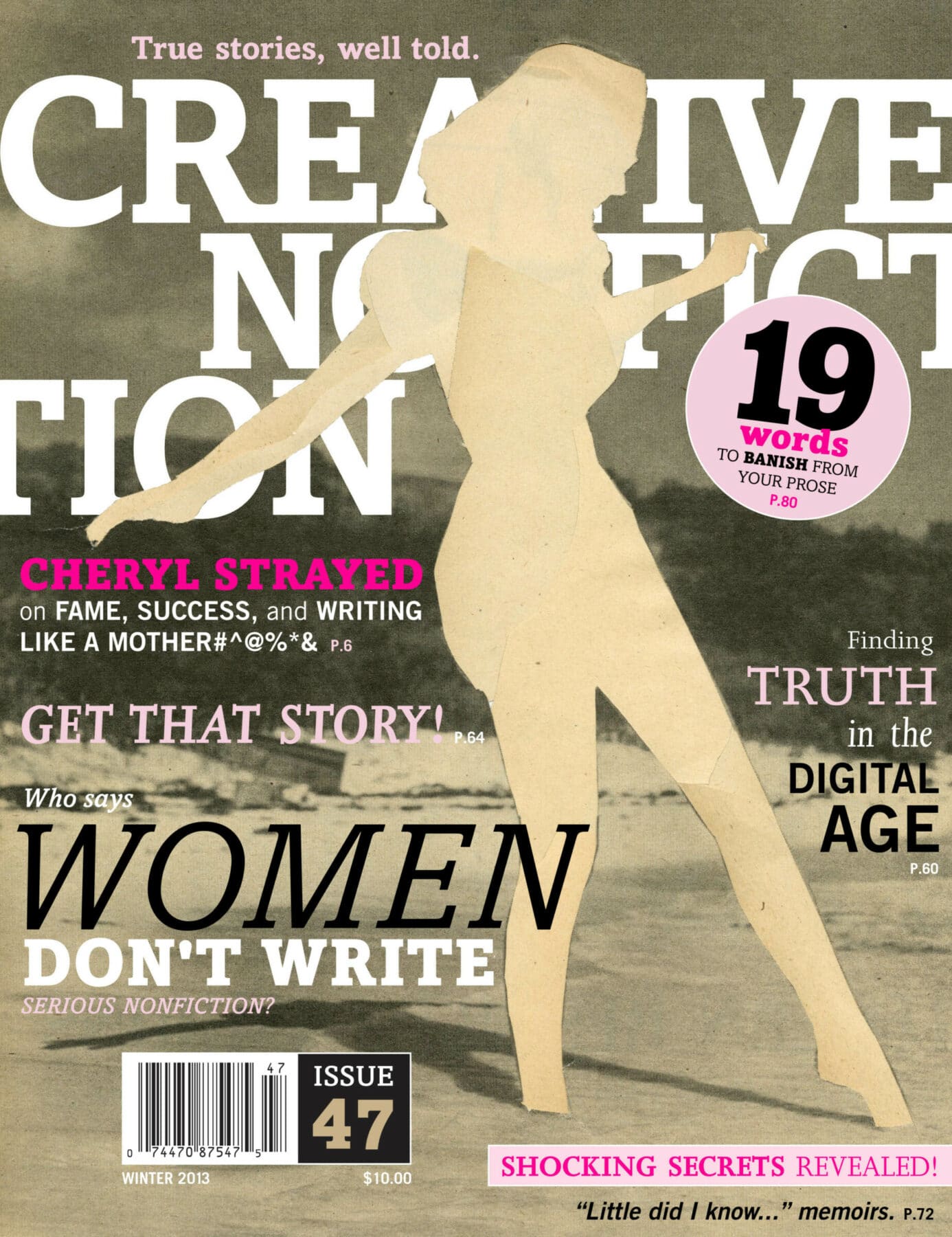Issue 47 / Winter 2013

47 / Female Form
Seriously beautiful essays about serious topics, all written by women
We didn’t set out to publish an all-women essay section, but as we were reading for this issue, we were drawn to a number of essays about, in some way, “the senses”—hearing, sight, etc. Or maybe it’s more accurate to say they’re about “perception.” And, it just so happened that these seriously beautiful essays about serious topics—entomology, ophthalmology, archaeology, molecular biology—were all written by women.
Plus: Elissa Bassist and Cheryl Strayed talk about how to write like a mother#^@%*&; exploring the possibilities of electronic literature; a roundtable discussion about the intersection of journalism and creative nonfiction; words to avoid in your prose; and more.
Already a subscriber?
Read this issue nowTable of Contents
What’s the Story #47
This issue of Creative Nonfiction features a dialogue with Cheryl Strayed, who has achieved fame and acclaim recently as the author of the runaway best seller Wild: From Lost to Found on the Pacific Crest Trail.Cheryl Strayed on Fame, Success, and Writing Like a Mother#^@%*&
In August 2010, a young writer named Elissa Bassist moved from San Francisco to Brooklyn to start working on an MFA in creative nonfiction. After living in New York for just two weeks, she wrote a letter to The Rumpus’s popular online advice columnist “Sugar,” expressing her frustrations about her writing: “I write about my lady life experiences, and that usually comes out as unfiltered emotion, unrequited love, and eventual discussion of my vagina as metaphor.The perils of “writing what you know”
A young mother sat next to me on her couch, avoiding the subject of her son, his surgery, and her fears. She stared at my head, not avoiding my eyes but mostly looking at my skull, until finally she said, “Your head looks normal.”The Memory Train
"Among the 15,000 items housed in the Warren Anatomical Museum in Boston is the skull of Phineas Gage, a railroad worker who survived after a large iron rod punctured his left frontal lobe."Elk Country
"Do you feel that? He turned and asked me, tucking the brim of his camouflaged cap up an inch on his forehead. How everything just got quieter?"The Collection
Sophomore Biology collection projects. We had three choices: leaves, fungi, or bugs. The lazy kids chose leaves—no shortage of trees in Wisconsin. The only hard part was pressing the leaves flat.Looking Back
I am suspended from his large brown eye. It is concentrating, peering closely into my own eye. I am afraid I will fall. I feel the heat of the lamp on my forehead, this surgeon’s hands on my face, and the sharp pressure of metal on my eye surfacing through the numbing drops.The Pit and the Page
"I can’t think about my mother, who is dying slowly and furiously. My grief is an unpacked box of sharp pieces stacked in a dark storeroom; I lug around a catalog of unfinished business."Regeneration
How to regenerate a human heartFar, Far Away
Here is what islanders agree on when they tell the story of Kendrick Britton: he was beautiful, tall, and wrapped in muscles he earned breaking gravel for construction projects in the days before it was imported.Creative nonfiction in our electronic age
This list offers links to examples of electronic nonfiction, a genre I discuss at greater length in Issue 47 of Creative Nonfiction. Here, I’ve chosen examples that are specifically made with and meant to be experienced on computers.Getting the Story: A Roundtable Discussion.
Are journalism and creative nonfiction mutually exclusive?The “Little Did I Know…” Memoir
Shocking discoveries that change everythingOrigin Stories
"School started again in the fall, my tan faded, I trudged into Saint Andrew the Apostle with scissors, Elmer’s Glue, a pencil case and brand new textbooks with pages that were blurry yet vivid to the touch..."The tao of find-replace
My own technology-enabled search-and-destroy mission began with the word maybe. There were nearly sixty maybes in my 300-page manuscript, a Microsoft Word-savvy critiquer pointed out. “More assertive statements,” she advised.Resurrecting Our Printed Past
"My primary source materials are vintage books and magazines—deemed no longer useful or relevant— and rescued from thrift stores and attics and antique shops. Maybe what I’m really trying to do is give these publications a second life."
